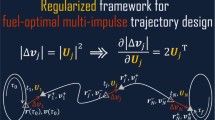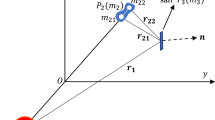Abstract
The equations of motion of an artificial satellite are given in nonsingular variables. Any term in the geopotential is considered as well as luni-solar perturbations up to an arbitrary power ofr/r′, r′ being the geocentric distance of the disturbing body. Resonances with tesseral harmonics and with the Moon or Sun are also considered. By neglecting the shadow effect, the disturbing function for solar radiation is also developed in nonsingular variables for the long periodic perturbations. Formulas are developed for implementation of the theory in actual computations.
Similar content being viewed by others
References
Allan, R. R.: 1965,Proc. Roy. Soc. A288, 60.
Jarnagin Jr, M. P.: 1965,Astron. Papers Am. Eph. Naut. Almanac 18, XXXVI.
Plummer, H. C.: 1960,Dynamical Astronomy, Ch. IV, Dover Publ., New York.
Tisserand, F.: 1889,Mechanique Celeste, Vol. I, Ch. XV, Gauthier-Villars, Paris.
Author information
Authors and Affiliations
Rights and permissions
About this article
Cite this article
Giacaglia, G.E.O. The equations of motion of an artificial satellite in nonsingular variables. Celestial Mechanics 15, 191–215 (1977). https://doi.org/10.1007/BF01228462
Received:
Issue Date:
DOI: https://doi.org/10.1007/BF01228462




